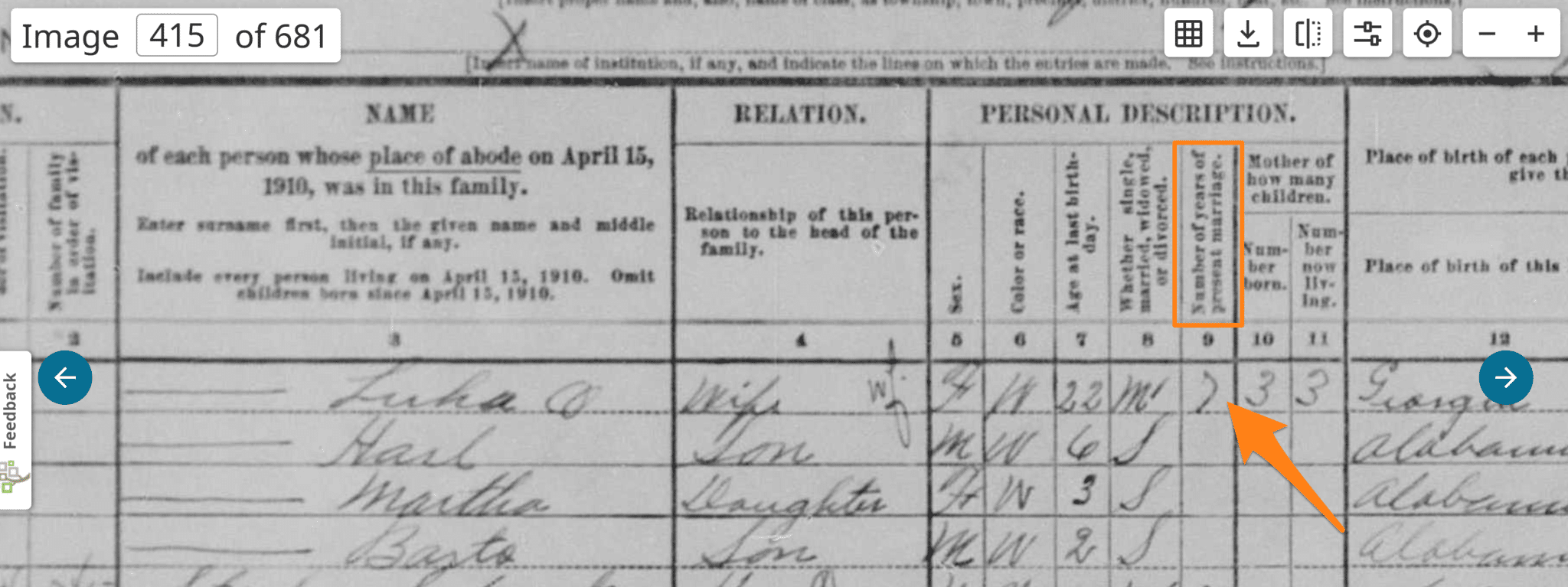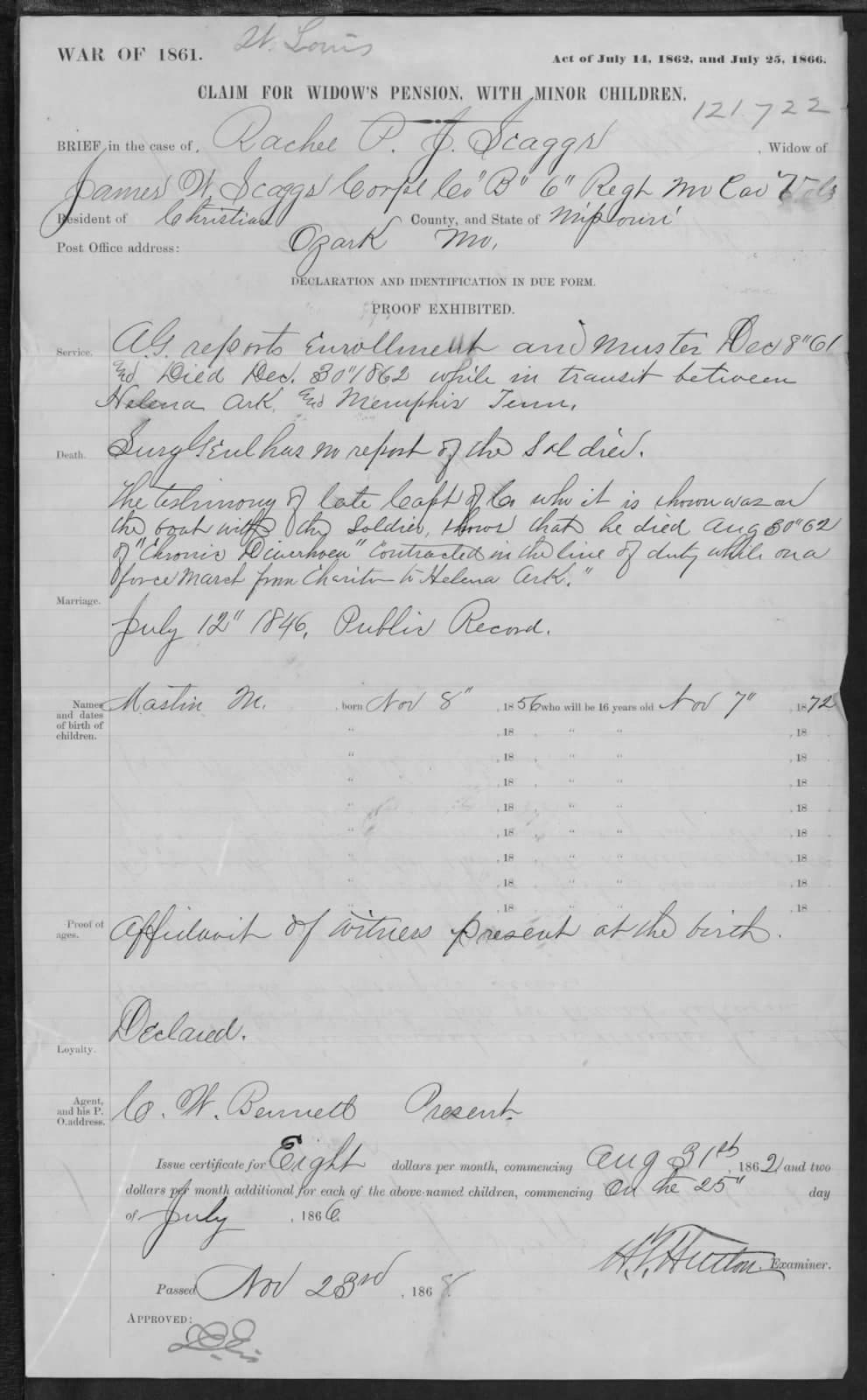Marriage details are some of the most important pieces of information we can add to our family tree, but they are not always easy to find. If you’ve looked in the expected places and cannot locate the date or location of a marriage for an ancestor you might have some unexpected luck with the record collections in this guide.
Where to Find a “Missing” Marriage Date or Location for Your Ancestor
Here are five places to look for marriage details when you can’t locate them in an obvious location – such as on a marriage certificate, church record, intention to marry document or divorce record.
1. U.S. Census Records
While we often turn to the census for details like an occupation, many people forget that these records contain marriage details as well. Of course, most years include marital status (which can help you narrow down a year of marriage between two people) but others also contain the number of years married, or even whether someone wed in the last year, helping you to get much closer to an exact date.
The 1870 census shows the exact marriage month, if the couple was married in the last year, while the 1880 census also notes if a person was married in the previous year (but does not include the month).
The years 1890 and 1900 include the number of years married, making it possible to estimate a marriage year (although the 1890 census was almost completely lost). Do be careful with this information, as some people who were interviewed may have understood this to mean ALL years of marriage, even when that included a previous spouse.
1910 asks for number of years in present marriage – which is more specific and helpful.
1920 skips this information, but 1930 asks for age at first marriage. Obviously, you’ll want to know if the person was married previously before using it to determine the date of marriage to their current spouse. Looking at the ages of the two people (if they are both listed) and the age at first marriage together can help you figure this out.
For instance, if Gerald is 43 on the census and age at first marriage was 28 and Anna is 46 and age at first marriage was 25, we know she was previously married. Presumably, she would have married at 25 to someone else, went through a divorce or was widowed, and then remarried Gerald around the age of 31.
Although it is also possible that Gerald was also previously married and that the two married later in life. You’ll need to use additional census years and other records to sort this out.
Unfortunately, the 1940 census only asks for this information from the 5% of the population that was randomly selected for supplementary questions – and only if they were female. Read The “Secret” Details on the 1940 Census You May Be Missing.
Although you won’t get exact dates and locations from a census record, these details will help you narrow down your search – making it more likely that you’ll be able to uncover another, more detailed, record with even more facts.
Always remember that the information found on a census is only as accurate as the person reporting it (and the enumerator) so don’t take everything at face value. We suggest looking at several census years together to come up with a better idea of ages and potential dates of marriage and then backing these dates up with other records.
Other census and population schedules from around the world include this information to varying degrees as well, so keep your eye out for it.
The screenshot below shows the Number of Years of Present Marriage box on a 1910 U.S. census on FamilySearch.
The best place to find free census record access is always FamilySearch. And don’t miss our guide to the U.S. Census for Genealogy for more help on what you can find in each census year.
2. Probate Records
Probate records are another underused source of information for marriage information. Wills and transfers of property often included information about a spouse – or children and their spouses.
Some death certificates or church death records also contain marriage details. The information found in these records can be used to gain clues about marriage dates and locations. On occasion, this information may even be included directly.
As with pension records (#5 on this list), probate records (especially wills) are a particularly good source for marriage details for those ancestors who lived during the Colonial era and/or before states started keeping regular marriage records in the mid 19th century.
- You can learn more about using Probate Records in this article
3. Old Newspapers
It’s probably no surprise that newspapers are one of the most detailed and exciting sources of marriage information. While marriages were often simply noted as a matter of public record (often helping you determine the date), other times more detailed announcements of wedding ceremonies or engagements and proposals were made – usually in the society section.
It takes some time and effort, and it will certainly be helpful to have a few key details before beginning your search (such as names and a general date range), but if you can find a marriage announcement you might get more than just a date and location. Family members’ names, the names of witnesses, details about the ceremony and who attended, occupations and more can be included in some of these finds.
To best locate an announcement when you don’t have a date, we suggest a general search for the maiden name and the married surname, as well as the first names of the spouses. Be flexible, as nicknames were often used and/or names were abbreviated or excluded in favor of Miss, Ms., Mrs. or Mr. Sometimes the maiden name is not listed at all. If you get too many results, try narrowing down the date range the best you can, as well as the location.
Just remember that a couple did not always marry in the town they lived in (although this was common). A marriage announcement may be found in the newspaper of a nearby town instead of a local paper, sometimes because no local paper existed or the paper was too small to publish announcements.
It’s very useful to take time to understand which newspapers were available for a town or county before beginning. Detailed help for this can be found in our online courses.
Here is an engagement announcement which includes a date of marriage from the Cincinnati Enquirer in 1923.
- Find out more about newspaper research through Chronicling America and in this article about Newspapers.com
4. City Directories
5. Service Pension Records
For ancestors who served, or their spouses, pension records can be a gold mine of personal information, including marriage dates and even locations. Widows’ pensions were often contingent on proving a marriage so the records might include marriage certificates or affidavits stating the marriage date and location. This is in addition to the wide variety of personal information and first-hand accounts that pension records often contain.
There are a surprising number of pension applications available online for you to look through but not all of them will be complete – some collections may only provide an index, partial transcriptions or exclude certain documentation. You’ll need to do some digging to see what exists for your ancestor, but you will be happy you did if you can find one of these records.
Below you can see the pension claim for a person whose husband served during the Civil War. Note the marriage date (under the marriage section) of July 12, 1846 as well as a mention of where this information came from (public record).
While you may not find a specific date or location of marriage in these records, many will provide you with the details you need to come close. You can then take that information and use it to more easily find a marriage certificate, church record or other document with the detailed information you want. Good luck with your search!
By Melanie Mayo, Family History Daily Editor




Need help finding marriage recordes in Hungary, Austria, Slovakia and Czech Republic, not just U.S. or England.
Unless you have a marriage certificate (or birth certificate), you have to be careful with census records also. I have found that the census records are not always correct either as a person’s age did not agree from one census to another. Sometimes people “fudged” on their ages or didn’t know their exact age or birth date. It’s just a guess if you don’t have another, verified source.
Thank you